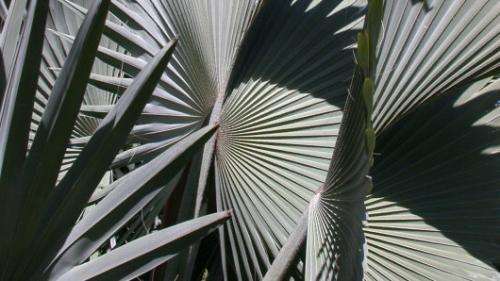Framework for palm biogeography: Researchers establish a hypothesis for the evolution of palms in time and space

A series of papers in scientific journals has established a general framework for the biogeographical evolution of palms.
In companion papers in the Journal of Biogeography, Bill Baker (Kew) and Thomas Couvreur (IRD, Montpellier) present a dated phylogenetic analysis of all palm genera with ancestral area reconstructions and detailed diversification analyses. They provide the first methodologically rigorous hypothesis for the evolution of palms in space and time, highlighting the Cretaceous crown node radiation of the family (ca. 100 Ma) in Laurasia and the role of long-distance dispersal as a major mechanism underpinning their global distribution.
The researchers' diversification studies suggest that the low species diversity of palms in Africa (65 species) relative to other regions is explained by increased in situ diversification in Asia, the Americas, the Pacific and the Indian Ocean, rather than Neogene extinctions in Africa as suggested by other authors.
The framework established in this study was used to analyse the phylogenetic foundations of palm distributions across Malesia for a paper in the book Biotic evolution and environmental change in Southeast Asia.
In a further study led by Aarhus University, published in Proceedings of the National Academy of Sciences of the USA, the dated phylogenetic tree was used in conjunction with geographical data for all palm species to explore the phylogenetic structure of palm assemblages worldwide and the imprints of historical processes in the resultant patterns. The results highlight the role of continental isolation, climate change and habitat loss throughout the Cenozoic for plant evolution in the Tropics.
More information: Baker, W.J. & Couvreur, T.L.P. (2013). Global biogeography and diversification of palms sheds light on the evolution of tropical lineages. I. Historical biogeography. Journal of Biogeography 40: 274–285.
Baker, W.J. & Couvreur, T.L.P. (2013). Global biogeography and diversification of palms sheds light on the evolution of tropical lineages. II. Diversification history and origin of regional assemblages. Journal of Biogeography 40: 286–298.
Baker, W.J. & Couvreur T.L.P. (2012). Biogeography and distribution patterns of Southeast Asian palms. In Biotic evolution and environmental change in Southeast Asia, Gower, D.J., K.G. Johnson, J.E. Richardson, B.R. Rosen, L. Rüber & Williams, S.T. (Eds.) Cambridge University Press. Pp. 165–189.
Kissling, W.D., Eiserhardt, W.L., Baker, W.J., Borchsenius, F., Couvreur, T.L.P., Balslev, H. & Svenning, J.C. (2012). Cenozoic imprints on the phylogenetic structure of palm species assemblages worldwide. Proceedings of the National Academy of Sciences of the United States of America 109, 7379–7384.
Journal information: Journal of Biogeography , Proceedings of the National Academy of Sciences
Provided by Royal Botanic Gardens, Kew










.jpg)
.jpg)
.jpg)





